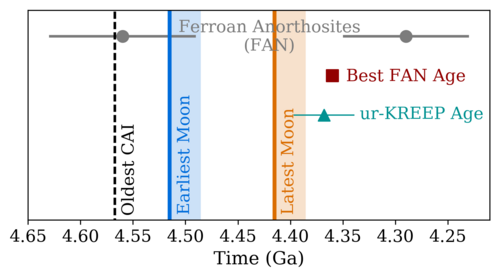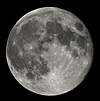달의 마그마 바다


달의 마그마 바다(Lunar Magma Ocean, LMO)는 달 표면에 존재했을 것이라 추정되는, 용융된 암석의 층이다. 달의 마그마 바다는 달이 형성된 약 45억 년 전에서[1] 그 후 몇천만에서 몇억 년가량 존재했으리라 추산된다. 달의 마그마 바다는 거대충돌로 인해 달이 급격히 형성됨으로 인한 열역학적 결과로, 달이 충돌 파편에서 강착될 때 위치 에너지가 열에너지로 전환되었고, 달이 1달에서 1년 사이 급격하게 강착되면서[2][3][4] 열에너지가 열복사할 시간이 충분하지 않아 달 표면에 갇혔다. 마그마 바다의 이후 과정을 통해, 달의 지각이 사장질인 이유, 유로퓸 이상, KREEP 물질을 설명할 수 있다.
달의 마그마 바다는 1970년 두 연구 단체가 각각 아폴로 11호에서 채취한 사장암 파편을 분석하여 처음 제안하였다.[5][6][7] 아폴로 계획에서 채취한, 철질 사장암은 90% 이상이 사장석으로 이루어져 있었다.[8] 구체적으로는, 철질 사장석은 칼슘을 단원소로 가진 사장석을 포함하였다.[9] 달의 사장암 순도가 높고 사장암의 녹는점은 높은 편이라는 점에서, 과거에 달의 상층부가 용융 상태였음을 알 수 있다.[10]

초기 상태
[편집]
달의 마그마 바다의 초기 상태를 결정하기 위해서는 3개 인자, 화학적 조성, 깊이, 온도가 중요한 영향을 끼치는데, 이 세 인자로서 열역학적 진화 과정이 결정되기 때문이다. 달의 마그마 바다에 대해서는 불확실성이 있지만, 보통 사용하는 수치는 47.1% SiO2, 33.1% MgO, 12.0% FeO, 4.0% Al2O3, 3.0% CaO에 초기 깊이 1000 km, 온도 1900 K이다.[16]
초기 화학 조성과 깊이
[편집]달의 마그마 바다의 초기 화학 조성은 달 표본의 성분과, 현재 달 지각의 성분 및 두께에서 결정할 수 있다. 컴퓨터 모델링에서는 화학 조성을 기본 분자 SiO2, MgO, FeO, Al2O3, CaO의 중량 백분율로 정의하며, 조성 자체는 지구의 맨틀과 유사하며, 내화물질의 구성비가 큰 증대가 일어나지 않는다는 차이가 있다.[11][15])
초기 깊이 추정은 100 km부터 달의 반지름 전체까지 다양하다.[20][16][21][22]
결정화 단계
[편집]광물이 결정화되는 구체적인 순서는 마그마 바다의 초기 상태에 기인한다. 보언의 반응 계열을 따르면, 감람석과 휘석이 제일 먼저 결정화된다. 이 광물은 주변 마그마보다 밀도가 높아 아래로 침강하게 되어, 마그마 바다는 바닥부터 굳는 것으로 보이게 된다. 마그마 바다가 80%가량 결정화되면, 사장석이 다른 광물과 함께 결정화되고, 사장석이 주를 이루는 사장암은 위로 떠올라 달의 원시 지각을 형성한다.
기간
[편집]달의 마그마 바다는 달의 형성 이후 몇천만에서 몇억 년가량 존재했을 것으로 보인다. 달의 형성 시기는, 태양계의 형성 시기로 추정되는 칼슘-알루미늄 포유물의 형성 이후 5200만 ~ 1억 5200만 년 사이로 추정되며,[1] 마그마 바다의 정확한 형성 시기는 따라서 불명이다. 반면 마그마 바다가 사라진 시기는 철질 사장암 표본 60025(43억 6000만±300만)와 KREEP의 추정 연도(43억 6800만±2900만)로서 비교적 정확히 추산할 수 있는데,[23] 만약 달이 일찍, 태양계 형성 후 5200만 년 후에 형성되었다면 표본과 KREEP 연도를 마그마 바다가 완전히 결정화된 시점으로 보아, 마그마 바다의 지속 기간은 1억 5500만 년이 된다. 이 경우 컴퓨터 모형에서는 조석 가열 등 어떠한 가열원이 있어 마그마 바다의 결정화를 지연시켜야 한다는 결과가 나온다.[24][25] 만약 달이 늦게, 1억 5200만 년 즈음 형성되었다면, 표본과 KREEP 연도를 통해 5500만 년 동안 존재했다는 결과가 나오며, 마그마 바다를 가열한 열원이 없었다는 뜻이 된다.

과거에는 철질 감람암 간 나이 차이를 통해 마그마 바다의 지속 기간을 측정하려 하였으나, 표본 나이의 오차가 너무 크고, 충돌이 일어나면 표본의 나이가 바뀐다는 점으로 인한 문제가 있다. 가장 오래 된 철질 감람암 표본은 67016으로 45억 6000만±7000만 년이고,[26] 가장 최근은 62236으로 42억 9000만±600만 년으로,[27] 둘 사이의 차이는 2700만 년으로 이 수치에 따르면 위와 마찬가지로 다른 가열원이 있어야 한다.[24]
반론
[편집]마그마 바다 이론에 대한 대표적인 대안은 단계적 마그마화 이론이다.[28][29]
각주
[편집]- ↑ 가 나 Touboul, Mathieu; Kleine, Thorsten; Bourdon, Bernard; Palme, Herbert; Wieler, Rainer (February 2009). “Tungsten isotopes in ferroan anorthosites: Implications for the age of the Moon and lifetime of its magma ocean”. 《Icarus》 199 (2): 245–249. doi:10.1016/j.icarus.2008.11.018. ISSN 0019-1035.
- ↑ Ida, Shigeru; Canup, Robin M.; Stewart, Glen R. (September 1997). “Lunar accretion from an impact-generated disk”. 《Nature》 389 (6649): 353–357. doi:10.1038/38669. ISSN 0028-0836. S2CID 19073356.
- ↑ Kokubo, E (December 2000). “Evolution of a Circumterrestrial Disk and Formation of a Single Moon”. 《Icarus》 148 (2): 419–436. doi:10.1006/icar.2000.6496.
- ↑ Takeda, Takaaki; Ida, Shigeru (2001년 10월 10일). “Angular Momentum Transfer in a Protolunar Disk”. 《The Astrophysical Journal》 560 (1): 514–533. doi:10.1086/322406. ISSN 0004-637X. S2CID 119060440.
- ↑ Smith, J. V.; Anderson, A. T.; Newton, R. C.; Olsen, E. J.; Wyllie, P. J. (July 1970). “A Petrologic Model for the Moon Based on Petrogenesis, Experimental Petrology, and Physical Properties”. 《The Journal of Geology》 78 (4): 381–405. doi:10.1086/627537. ISSN 0022-1376.
- ↑ Wood, J. A.; Dickey, J. S.; Marvin, U. B.; Powell, B. N. (1970년 1월 30일). “Lunar Anorthosites”. 《Science》 167 (3918): 602–604. doi:10.1126/science.167.3918.602. ISSN 0036-8075. PMID 17781512. S2CID 20153077.
- ↑ “Apollo Sample Description”. 《curator.jsc.nasa.gov》. 2019년 9월 29일에 확인함.
- ↑ “PSRD: The Oldest Moon Rocks”. 《www.psrd.hawaii.edu》. 2019년 9월 27일에 확인함.
- ↑ Dowty, Eric; Prinz, Martin; Keil, Klaus (November 1974). “Ferroan anorthosite: A widespread and distinctive lunar rock type”. 《Earth and Planetary Science Letters》 24 (1): 15–25. doi:10.1016/0012-821x(74)90003-x. ISSN 0012-821X.
- ↑ Reynolds, Stephen J. (2015년 1월 12일). 《Exploring geology》. Shaw, Cynthia C. Four판. New York, NY. 123쪽. ISBN 9780078022920. OCLC 892304874.
- ↑ 가 나 Taylor, Stuart (1982). 《Planetary Science: A Lunar Perspective》. Lunar and Planetary Institute.
- ↑ 가 나 Elardo, Stephen M.; Draper, David S.; Shearer, Charles K. (June 2011). “Lunar Magma Ocean crystallization revisited: Bulk composition, early cumulate mineralogy, and the source regions of the highlands Mg-suite”. 《Geochimica et Cosmochimica Acta》 75 (11): 3024–3045. doi:10.1016/j.gca.2011.02.033. ISSN 0016-7037.
- ↑ O'Neill, H.St.C (April 1991). “The origin of the moon and the early history of the earth—A chemical model. Part 1: The moon”. 《Geochimica et Cosmochimica Acta》 55 (4): 1135–1157. doi:10.1016/0016-7037(91)90168-5. ISSN 0016-7037.
- ↑ Schwinger, S.; Breuer, D. (2018년 12월 1일). “Modeling the Thermochemical Evolution of the Lunar Magma Ocean using Igneous Crystallization Programs”. 《AGU Fall Meeting Abstracts》 31: P31G–3778. Bibcode:2018AGUFM.P31G3778S.
- ↑ 가 나 Longhi, John (December 2006). “Petrogenesis of picritic mare magmas: Constraints on the extent of early lunar differentiation”. 《Geochimica et Cosmochimica Acta》 70 (24): 5919–5934. doi:10.1016/j.gca.2006.09.023. ISSN 0016-7037.
- ↑ 가 나 다 Elkins-Tanton, Linda T.; Burgess, Seth; Yin, Qing-Zhu (April 2011). “The lunar magma ocean: Reconciling the solidification process with lunar petrology and geochronology”. 《Earth and Planetary Science Letters》 304 (3–4): 326–336. doi:10.1016/j.epsl.2011.02.004. ISSN 0012-821X.
- ↑ Morgan, John W.; Hertogen, Jan; Anders, Edward (June 1978). “The moon: Composition determined by nebular processes”. 《The Moon and the Planets》 18 (4): 465–478. doi:10.1007/bf00897296. ISSN 0165-0807. S2CID 122394276.
- ↑ Ringwood, A. E.; Kesson, S. E. (1976년 4월 1일). “A dynamic model for mare basalt petrogenesis”. 《Lunar and Planetary Science Conference Proceedings》 7: 1697–1722. Bibcode:1976LPSC....7.1697R.
- ↑ Warren, Paul H. (1986년 3월 30일). “Anorthosite assimilation and the origin of the Mg/Fe-related bimodality of pristine moon rocks: Support for the magmasphere hypothesis”. 《Journal of Geophysical Research: Solid Earth》 91 (B4): 331–343. doi:10.1029/jb091ib04p0d331. ISSN 0148-0227.
- ↑ Andrews-Hanna, J. C.; Asmar, S. W.; Head, J. W.; Kiefer, W. S.; Konopliv, A. S.; Lemoine, F. G.; Matsuyama, I.; Mazarico, E.; McGovern, P. J. (2012년 12월 5일). “Ancient Igneous Intrusions and Early Expansion of the Moon Revealed by GRAIL Gravity Gradiometry”. 《Science》 339 (6120): 675–678. doi:10.1126/science.1231753. ISSN 0036-8075. PMID 23223393. S2CID 18004181.
- ↑ Rapp, J. F.; Draper, D. S. (2018년 4월 16일). “Fractional crystallization of the lunar magma ocean: Updating the dominant paradigm”. 《Meteoritics & Planetary Science》 53 (7): 1432–1455. doi:10.1111/maps.13086. ISSN 1086-9379.
- ↑ Solomon, S. C.; Chaiken, J. (1976년 4월 1일). “Thermal expansion and thermal stress in the moon and terrestrial planets - Clues to early thermal history”. 《Lunar and Planetary Science Conference Proceedings》 7: 3229–3243. Bibcode:1976LPSC....7.3229S.
- ↑ 가 나 Borg, Lars E.; Gaffney, Amy M.; Shearer, Charles K. (2015). “A review of lunar chronology revealing a preponderance of 4.34–4.37 Ga ages”. 《Meteoritics & Planetary Science》 50 (4): 715–732. doi:10.1111/maps.12373. ISSN 1945-5100.
- ↑ 가 나 Chen, Erinna M.A.; Nimmo, Francis (September 2016). “Tidal dissipation in the lunar magma ocean and its effect on the early evolution of the Earth–Moon system”. 《Icarus》 275: 132–142. doi:10.1016/j.icarus.2016.04.012. ISSN 0019-1035.
- ↑ Perera, Viranga; Jackson, Alan P.; Elkins-Tanton, Linda T.; Asphaug, Erik (May 2018). “Effect of Reimpacting Debris on the Solidification of the Lunar Magma Ocean”. 《Journal of Geophysical Research: Planets》 123 (5): 1168–1191. doi:10.1029/2017je005512. hdl:10150/628510. ISSN 2169-9097. S2CID 55542872.
- ↑ 가 나 Alibert, Chantal; Norman, Marc D.; McCulloch, Malcolm T. (July 1994). “An ancient Sm-Nd age for a ferroan noritic anorthosite clast from lunar breccia 67016”. 《Geochimica et Cosmochimica Acta》 58 (13): 2921–2926. doi:10.1016/0016-7037(94)90125-2. ISSN 0016-7037.
- ↑ 가 나 Borg, Lars; Norman, Marc; Nyquist, Larry; Bogard, Don; Snyder, Greg; Taylor, Larry; Lindstrom, Marilyn (October 1999). “Isotopic studies of ferroan anorthosite 62236: a young lunar crustal rock from a light rare-earth-element-depleted source”. 《Geochimica et Cosmochimica Acta》 63 (17): 2679–2691. doi:10.1016/s0016-7037(99)00130-1. ISSN 0016-7037.
- ↑ Gross, J.; Treiman, A. H.; Mercer, C. N. M. (March 2012). “Sinking the Lunar Magma Ocean: New Evidence from Meteorites and the Return of Serial Magmatism”. 《Lunar and Planetary Science Conference》 (1659): 2306. Bibcode:2012LPI....43.2306G.
- ↑ Gross, Juliane; Treiman, Allan H.; Mercer, Celestine N. (February 2014). “Lunar feldspathic meteorites: Constraints on the geology of the lunar highlands, and the origin of the lunar crust”. 《Earth and Planetary Science Letters》 388: 318–328. doi:10.1016/j.epsl.2013.12.006. ISSN 0012-821X.
